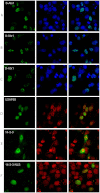The importance of serine 776 in Ataxin-1 partner selection: a FRET analysis
- PMID: 23213356
- PMCID: PMC3513968
- DOI: 10.1038/srep00919
The importance of serine 776 in Ataxin-1 partner selection: a FRET analysis
Abstract
Anomalous expansion of a polymorphic tract in Ataxin-1 causes the autosomal dominant spinocerebellar ataxia type 1. In addition to polyglutamine expansion, requirements for development of pathology are phosphorylation of serine 776 in Ataxin-1 and nuclear localization of the protein. The phosphorylation state of serine 776 is also crucial for selection of the Ataxin-1 multiple partners. Here, we have used FRET for an in cell study of the interaction of Ataxin-1 with the spliceosome-associated U2AF65 and the adaptor 14-3-3 proteins. Using wild-type Ataxin-1 and Ser776 mutants to a phosphomimetic aspartate and to alanine, we show that U2AF65 binds Ataxin-1 in a Ser776 phosphorylation independent manner whereas 14-3-3 interacts with phosphorylated wild-type Ataxin-1 but not with the mutants. These results indicate that Ser776 acts as the molecular switch that discriminates between normal and aberrant function and that phosphomimetics is not a generally valid approach whose applicability should be carefully validated.
Figures






Similar articles
-
Phosphorylation of S776 and 14-3-3 binding modulate ataxin-1 interaction with splicing factors.PLoS One. 2009 Dec 23;4(12):e8372. doi: 10.1371/journal.pone.0008372. PLoS One. 2009. PMID: 20037628 Free PMC article.
-
14-3-3 Binding to ataxin-1(ATXN1) regulates its dephosphorylation at Ser-776 and transport to the nucleus.J Biol Chem. 2011 Oct 7;286(40):34606-16. doi: 10.1074/jbc.M111.238527. Epub 2011 Aug 11. J Biol Chem. 2011. PMID: 21835928 Free PMC article.
-
Identification of a novel phosphorylation site in ataxin-1.Biochim Biophys Acta. 2005 May 15;1744(1):11-8. doi: 10.1016/j.bbamcr.2004.10.012. Epub 2004 Nov 10. Biochim Biophys Acta. 2005. PMID: 15878393
-
14-3-3 proteins and spinocerebellar ataxia type 1: from molecular interaction to human neuropathology.Cerebellum. 2010 Jun;9(2):183-9. doi: 10.1007/s12311-010-0158-9. Cerebellum. 2010. PMID: 20155408 Review.
-
Progress in pathogenesis studies of spinocerebellar ataxia type 1.Philos Trans R Soc Lond B Biol Sci. 1999 Jun 29;354(1386):1079-81. doi: 10.1098/rstb.1999.0462. Philos Trans R Soc Lond B Biol Sci. 1999. PMID: 10434309 Free PMC article. Review.
Cited by
-
A single phosphorylation site of SIK3 regulates daily sleep amounts and sleep need in mice.Proc Natl Acad Sci U S A. 2018 Oct 9;115(41):10458-10463. doi: 10.1073/pnas.1810823115. Epub 2018 Sep 25. Proc Natl Acad Sci U S A. 2018. PMID: 30254177 Free PMC article.
-
Kaleidoscopic protein-protein interactions in the life and death of ataxin-1: new strategies against protein aggregation.Trends Neurosci. 2014 Apr;37(4):211-8. doi: 10.1016/j.tins.2014.02.003. Epub 2014 Mar 11. Trends Neurosci. 2014. PMID: 24636457 Free PMC article. Review.
-
Mapping the self-association domains of ataxin-1: identification of novel non overlapping motifs.PeerJ. 2014 Mar 25;2:e323. doi: 10.7717/peerj.323. eCollection 2014. PeerJ. 2014. PMID: 24711972 Free PMC article.
-
Pathogenic mechanisms underlying spinocerebellar ataxia type 1.Cell Mol Life Sci. 2020 Oct;77(20):4015-4029. doi: 10.1007/s00018-020-03520-z. Epub 2020 Apr 18. Cell Mol Life Sci. 2020. PMID: 32306062 Free PMC article. Review.
-
Human Mesenchymal Stem Cell-Derived Exosomes as Engineering Vehicles of Daunorubicin for Targeted c-Mpl+ AML Therapy.Int J Nanomedicine. 2025 Apr 24;20:5267-5289. doi: 10.2147/IJN.S511713. eCollection 2025. Int J Nanomedicine. 2025. PMID: 40297403 Free PMC article.
References
-
- Orr H. T., Chung M. Y., Banfi S., Kwiatkowski T. J. Jr., Servadio A., Beaudet A. L., McCall A. E., Duvick L. A., Ranum L. P. & Zoghbi H. Y. Expansion of an unstable trinucleotide CAG repeat in spinocerebellar ataxia type 1. Nat. Genet. 4, 221–226 (1993). - PubMed
-
- Zoghbi H. Y. & Orr H. T. Spinocerebellar ataxia type 1. Semin. Cell Biol. 6, 29–35 (1995). - PubMed
-
- Matilla-Dueñas A., Goold R. & Giunti P. Clinical, genetic, molecular, and pathophysiological insights into spinocerebellar ataxia type 1. Cerebellum 7, 106–114 (2008). - PubMed
-
- Cummings C. J., Mancini M. A., Antalffy B., DeFranco D. B., Orr H. T. & Zoghbi H. Y. Chaperone suppression of aggregation and altered subcellular proteasome localization imply protein misfolding in SCA1. Nat. Genet. 19, 148–154 (1998). - PubMed
Publication types
MeSH terms
Substances
Grants and funding
LinkOut - more resources
Full Text Sources
Molecular Biology Databases

